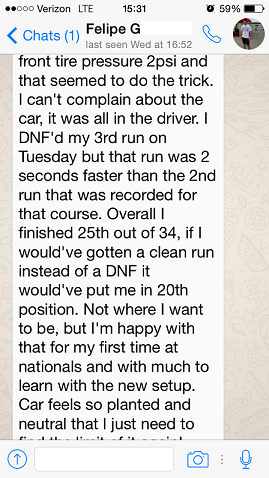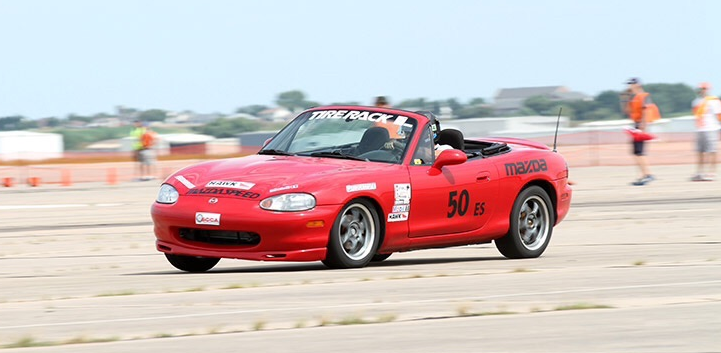Felipe got in touch with me in early Summer 2015, just a few months before Solo Nationals. He'd been tuning his 99 Miata for a while using Koni Sports and felt he had gotten as much out of that setup as he could. From browsing the Miata.net forum and talking with local racers who had been successfully using our FCM Elite Bilstein based dampers, he was ready to take his setup to the next level and do the best he could in his first Solo Nationals event.
Beginning to work with him was really good timing for me, as I had just the previous year seen several customers do very well with our newer Elite tuning methods, in particualr the experience our long-term Elite customer Mike R had. Earlier in 2014, Mike got back in touch with me after having an Elite setup for a few years. He wanted to see if we had any new tricks and yes indeed, I told him about our FCM Elite KBO (Kerb Blow-Off) option. Mike ordered a new set of dampers and received them shortly before the the SCCA Solo2 Packwood National Tour. You can go here to listen in on the phone conversation I had with Mike after his win (yes, it's a blank screen).
Since 2013 we'd already had our novel and incredibly elegant KBO (Kerb Blow-Off) technology added to dozens of street and track Elite builds. KBO allows us to use more low-speed compression damping which gives excellent body control without the penalty from too much low-speed rebound, as the majority of cheaper twin-tube and overzealous racers use. The fastest setups I've studied and built all focus on using compression to provide sharp transitional response and chassis control instead of emphasizing rebound which creates 'jacking down' that makes for an unstable setup (as Felipe himself notes in the comments / text screen caps below).
In early 2014, after working with some off-road and large solid-axle vehicle applications, I was inspired to test some of those ideas for street and race builds. I tested on our BMW sedan, then multiple Miatas, what I call Ripple Reducer which is the highest bang-for-the-buck technology we offer. It works by reducing the impact of small-displacement, higher-frequency oscillation (i.e. road rumble and surface roughness) on the damper's response. This keep the tires from 'pattering' across the ground, which is often perceived as an annoying background 'hum' but is also actually robbing grip. You can have two dyno graphs that look the same, but the differences will show up when you examine the higher-frequency / smaller amplitude response of the damper which most dynos aren't capable of showing - but you certainly feel the impact!
Mike R. has since moved on from autocross but his review was something I mentioned to Felipe. Budget is often a factor so Felipe decided to start with our FCM Elite (non-adjustable) damping to his Hard S Bilsteins, using our latest damping methods. He did add our Ripple Reducer technology which was a wise choice. Even though Mike loved his KBO Elite setup from us, I was able to get even better street ride (and autocross grip) with softer high speed rebound damping (something the Koni Sport is notorious for generating FAR too much of!). This softened rebound and intelligently-chosen bump stop rates and lengths combined to make the suspension work in a very fluid, even way that maintained grip on rougher surfaces and also gave a surprisingly good street ride - win win!
So Felipe was going to benefit from the latest discoveries I'd made in as I discuss in this video about Street class autocross tuning about making sure you're not losing suspension travel after each bump or dip. He'd also take advantage of the grip-enhancing capabilities that the 'off-road racing' inspired Ripple Reducer provided.
These are Felipe's comments about his FCM Elite E Street build upon initial installation and first event, with his text transcribed after the screen captures.


"I am so much faster. One section I am considerably faster is the slaloms. Car is just planted. Took me a few runs to find its new limit. Once the OTS konis were near the limit, they were just unpredictable; the Fat Cats are so so "smooth." Adams fastest run in my car was a 48.7 and mine was a 48.8 so I'm right there.
Yes, just let me know when you want to chat about my new setup and feedback. It was nice testing both shock setups so soon. Time for nationals! You should try to make it out there this year!"
A few weeks later he sent me this update:

"Adam A, a local hot shot that has a set of your single adjustable shocks, took a couple laps in my car today. He likes your new valving a lot more than what he has. He called it 'smooth as silk', car is so much more nimble now, it's hard to upset it, even with all the body roll. No under steer, or oversteer, it is perfect. Thank you so much!"
Then, I checked in with him after his time at Nationals - which again, was his first!


"Hey! I had a fantastic time at nationals! I definitely need more practice on bigger courses. In Minnesota we run in small small lots and don't get exposed to those big lots with lots of grip like Lincoln. Closest like that for me is in Milwaukee, which I'll have to start attending. Car was great, a little pushy so I added a 3mm packer in the rear and lowered the front tire pressure 2psi and that seemed to do the trick. I can't complain about the car, it was all in the driver. I DNF'd my 3rd run on Tuesday but that run was 2 seconds faster than the 2nd run that was recorded for that course. Overall I finished 25th out of 34, if I would've gotten a clean run instead of a DNF it would've put me in 20th position. Not where I want to be, but I'm happy with that for my first time at nationals and with much to learn with the new setup. Car feels so planted and neutral that I just need to find the limits..."

If you're reading this and aren't specifically interested in Street class, we also have been and continue to build KBO into height-adjustable coilover setups. A review from Jeff 'Goji' on his FCM Elite KBO coilover setup is here.
And I also love to include this great review from some professional drivers (Kai Goddard and Alan McCallum) on how our Elite suspension did on a 25 Hours of Thunderhill Lexus IS250 we worked on in 2014. We gave them no knobs and they were RELIEVED! The suspension just worked right out the gate, as they say themselves. 'A breath of fresh air' was Kai's quote.
To Knob or not to Knob? That is the question...
Having autocrossed competitively and trophied myself, plus worked with drivers of all experience levels, I understand there is a place for knobs. It can help to fine-tune vehicle behavior at the nth-degree level, but you get 95% of the total performance and grip without needing the complexity and costs of adjustments. I have found that the window where you can achieve excellent handling is very close to the window where you achieve ultimate grip. There is an orientation in many (but not all) factory suspension engineers toward 'adding more damping' to get tighter transient control when more is not necessarily better. I've seen this for years with our elegant, non-active controlled FCM Elite suspensions. By focusing your DESIGN on maximum grip, maximum road-holding, maximum comfort, you get the LUCKY outcome of having a very well-handling, responsive, confidence-inspiring vehicle.
We've proven that through keeping it simple - designing for efficiency, durability, and harmony - we also get the best road-holding. We demonstrate that our suspension has better grip and better ride quality than the factory C5 Z06 suspension which was lauded as being exceptionally well-tuned on a rough road course (the Nurburgring in Germany). We did this without our KBO technology which I also know is another technological advantage over standard digressive or linear pistons which are common through the automobile industry. I would be very interested in a back-to-back test of all our best FCM Elite technology and tuning methods against a more expensive semi-active damping system!
